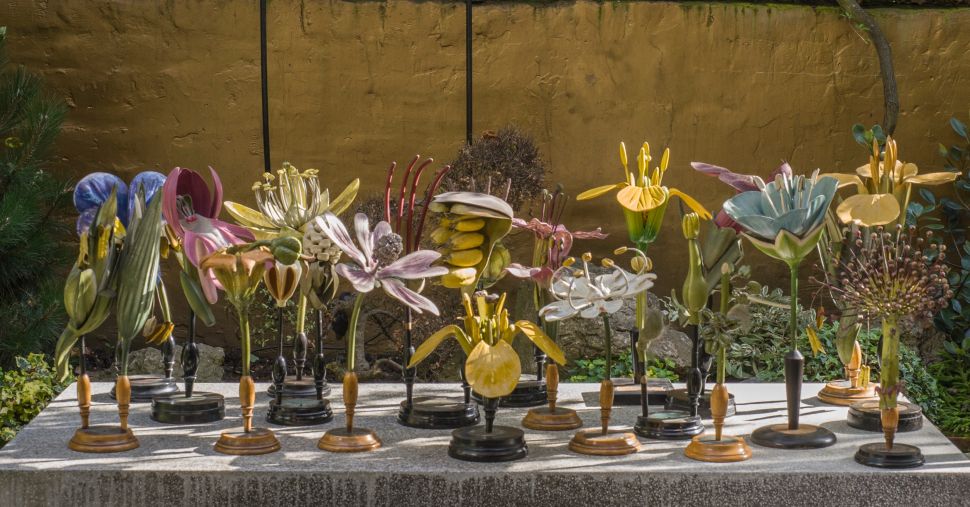Hot on the heels of the Venice Biennale, an exhibition at the Museo di Palazzo Grimani pairs objects and illustrations from 19th-century life sciences from the George Loudon Collection in England with art and artifacts loaned by international museums, cultural institutions and private collectors plus works from the Palazzo Grimani collection. “A Cabinet of Wonders: A Celebration of Art in Nature” even reconstructs a 17th-century Wunderkammer, better known as a cabinet of curiosities, perhaps teeming with miniature crocodiles, bottled herbs, archaeological finds and pressed flowers, first popularized in 16th-century Europe. But despite the show’s narrowly demarcated name, the palatial palazzo’s exhibit sprawls across several rooms, including its chapel, dining room, Neoclassical room and more.
Small corners and tables scattered across the museum showcase eloquently lined-up analog learning devices. In one small room, anatomical sculptures, like skeletons, hearts and skulls, have been mounted on the walls. Moving on, paintings and other objets d’art hang from floor to ceiling near a motley assortment of items like seashells, vases and goblets.
Loudon is the author of Object Lessons: The Visualisation of Nineteenth-Century Life Sciences and a collector who specializes in 19th-century scientific artifacts, many of which he acquired while on his travels. For more than two decades, he has collected not just contemporary art but also medical illustrations and scientific models, with works by Charles Darwin, naturalist Alfred Russel Wallace and zoologist Ernst Haeckel.
He began collecting life science artifacts in earnest in 2004 when he discovered Harvard University’s “Glass Flowers,” otherwise known as the Ware Collection of Blaschka Glass Models of Plants, the university’s collection of artfully made flowers commissioned in 1886 by Professor George Lincoln Goodale (the first director of Harvard’s Botanical Museum). The models were produced from 1887 to 1936 by artists like Leopold and Rudolf Blaschka, father-and-son glass artists who lived and worked in Germany.
SEE ALSO: Rare Medical Books From the Collection of Eugene S. Flamm Are Coming to Christie’s
Interest thus piqued, Loudon then sought to find other such curiosities hiding in plain sight. He visited over fifty different university and museum storages around the world to uncover rare and hidden treasures handmade by anonymous craft makers whose work represents the crossroads of science, art and 19th-century education.
On view in “A Cabinet of Wonders” are the Leçons de choses (object lessons) created by M. Pitoiset for French primary schools and a select number of Blaschka botanical glass models, as well as Japanese globes and Italian wax plant and fruit models. These intricately crafted pieces are examples of innovations that emerged in the 19th Century, like nature printing and early photographic methods like cyanotype.
Of course, there is Italian art in the exhibition, too. Highlights include a painting by Jacopo Robusti, known as Tintoretto, Adam and Eve Before God from the 16th Century and a portrait of archbishop Giovanni Grimani by the same artist from the early 17th Century. There are never-before-exhibited works by Venetian icons such as Titian and Veronese. Nearby are anatomical figures of men from the 19th Century—artifacts of the time, certainly, but also art.
Here, the remarkable collection of Loudon is presented as an art installation for the first time. “George Loudon’s insatiable curiosity for the natural and scientific worlds soon guided him to uncover the beauty and magic within objects and illustrations from 19th-century life sciences,” writes curator Thierry Morel. “In this scenographic odyssey, artifacts emerge from shadowed origins, shedding their utilitarian pasts to reveal themselves as exquisite works of art, radiant with unexpected poetry.”
Loudon is one of the few art collectors to seriously branch out into 19th-century life sciences illustrations and models. When industrially produced versions eventually replaced these, the handcrafted originals were often left to collect dust in museum storage unless they found their way into pop culture. But these illustrations and models are objets d’art and a celebration of long-lost craftsmanship—and proof that collecting art doesn’t always have to mean collecting paintings.
“A Cabinet of Wonders: A Celebration of Art in Nature” is at the Museo di Palazzo Grimani through May 11, 2025.

